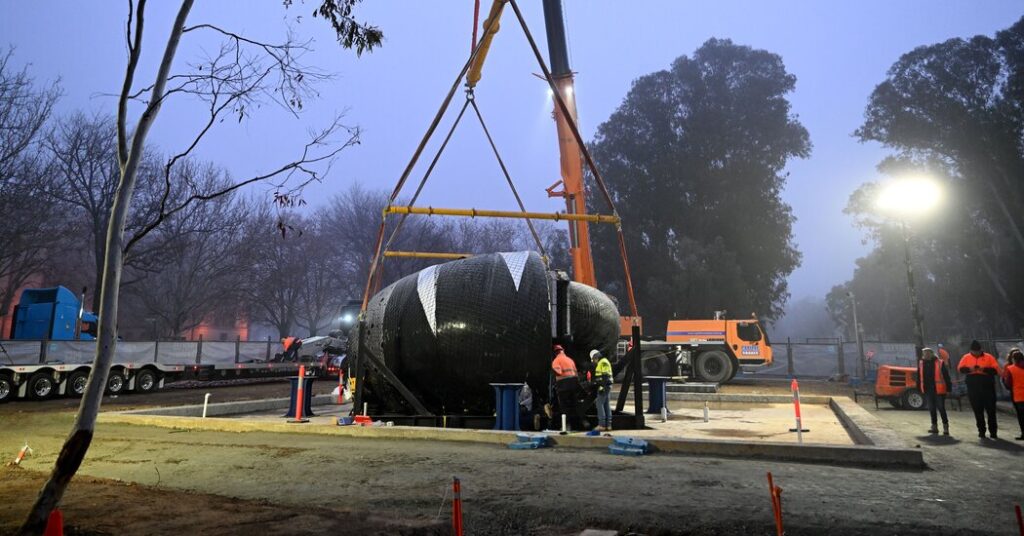The Australia Letter is a weekly newsletter from our Australia bureau. Sign up to get it by email. This week’s issue is written by Julia Bergin, a reporter based in the Northern Territory.
A vehicle swerves from left to right across three lanes on the highway.
“You’ve got 100 millimeters on your left side. Keep steady, keep straight,” its driver says into a radio.
He is tailed by two vehicles fitted with rooftop road signs that warn of an “oversize load ahead.” Next comes a police escort two cars strong, and finally, the centerpiece of the convoy: a huge truck coasting along with an artwork weighing about 14 tons.
Covered in film and netting, and locked in place with a heavy frame, the massive metal sculpture is worth nearly $10 million. Earlier this week, its convoy of support vehicles stretched out on the road for just shy of a mile. To get to its destination, the whole apparatus spent five and half days traveling from Brisbane to the nation’s capital, Canberra. There, at the National Gallery of Australia, the piece, by an Australian artist named Lindy Lee and titled “Ouroboros,” will remain for a projected 500 years.
Maybe, considering time and space, it’s a short drive for a long stay. Maybe to some, it’s not that special: All around the world, art is wrapped, packaged and piled into various modes of transport to travel from point A to B. And yet, in Australia, the country’s geographical vastness and unique challenges produce experiences that few art movers elsewhere would find familiar.
Nick Mitzevich, the director of the National Gallery of Australia, said it’s not uncommon for artworks to go by ship, circumnavigating the country, instead of by truck. That’s because bumps, dust, extreme heat, mountainous terrain, and curvy roads can inflict damage.
“It’s not necessarily the shortest route we’re after, but rather the route that will have the least impact on the work of art,” Mr. Mitzevich said, explaining why Ms. Lee’s highly polished stainless-steel rendition of a giant snake eating its tail took the “scenic trail.”
Driving direct from Brisbane to Canberra is about 735 miles, but the convoy carrying the sculpture traveled about 1,240. It passed through three separate jurisdictions — Queensland, New South Wales and the Australian Capital Territory — traversing dense city streets by night and long, open stretches of country highway by day.
There were delays caused by fog, unexpected roadwork, oncoming traffic that ignored police blocks, and on-the-move road maintenance including sign removal and tree lopping. Depending on hazards and conditions, the vehicles moved as slow as three miles per hour and as fast as 50.
Ms. Lee, the creator of “Ouroboros,” traveled with the convoy for the entire journey and said she was in awe of the drivers’ capacity to navigate treacherous terrain and impossibly tight spaces.
“I scrape my tiny car reversing out of a Westfield car park!” she said, referring to one of Australia’s main shopping centers. “And they were driving this huge vehicle within literally an inch of the walls.”
She marveled at the skill and scale of an operation that broke records — who knew it would be the largest item to move through Canberra’s downtown?
With typical Australian understatement, the man in charge of transport, Jon Kelly from Heavy Hauling Assets, said the move itself was not difficult.
During the 25 years Mr. Kelly has been in business, he and his team have transported items including offshore oil drilling equipment measuring 74 yards in height and 38 yards wide, tunnel-boring machines and cranes. Although moving an artwork was a first for him, Mr. Kelly said the same technical rules applied.
“From an execution point of view, it was a solid 2 out of 10. But clerically, it was an 11.75 out of 10,” he said with a laugh, reeling off two years’ worth of approvals, permits, feasibility studies, and proficiency tests required to prove his company was up to the job.
“You’re dealing with Canberra, you’re dealing with a National Gallery and you’re dealing with people and consortiums that are used to moving items that are one-tenth of the scale,” he added. “They’re from very different walks of life to my transport world, and they’re quite a nervous bunch.”
Although transportation is familiar to the art world, few artists have much to do with it. Typically, works are either finished and shipped off to where they need to go, or an artist will assemble it on site.
But for Ms. Lee and Mr. Kelly, a week on the road with “Ouroboros” soon bridged that divide and dispelled any clichéd assumptions they might have held about each other’s worlds.
“I honestly thought that Lindy would come for the first couple of hours and then fade off and meet us in Canberra, but she was steadfast the whole trip, ” Mr. Kelly said. “She did not leave the side of my operators or the trucks for the full duration of the journey.”
“I think,” he added, “that she’s actually a converted mega-trucker now.”
The commute was also a cultural experience for the broader community of truckers, who encountered the sculpture and its high-security entourage when it pulled up at a heavy-vehicle rest area in a major country town.
Ms. Lee said there was a lot of gawking, head scratching, and questions about what on earth it was. But for her, explaining to onlookers that her artwork was not an intergalactic import only added to the purpose of the piece.
“My work is about connection,” Ms. Lee said.
“I’m changed from this, I really am, and it’s because of the wondrousness of them.”
Now here are this week’s stories.
Around The Times
Are you enjoying our Australia bureau dispatches?
Tell us what you think at [email protected].
Like this email?
Forward it to your friends (they could use a little fresh perspective, right?) and let them know they can sign up here.


